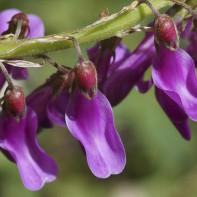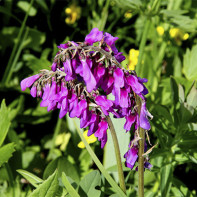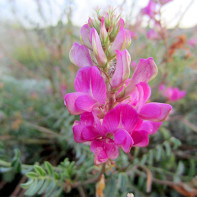Mullein: medicinal properties and contraindications
Kopecnik surprises not only with its unusual name, no less interesting is the fate of this red-listed plant. From time immemorial, Siberian herbalists prepared decoctions from this herb, which raised hopelessly ill people and endowed healthy ones with bogatyr strength. That is why in the days when illiterate people trusted shamans and herbalists, medicines from kopeck were considered an elixir of life and longevity. About this plant in the people there were legends, some of which have survived to this day.
- Chemical composition
- How it looks and where it grows
- External signs
- Area of distribution
- Types
- Harvesting and storage
- Therapeutic properties of comfrey
- For Women
- For Men
- Kopecks in folk medicine
- Heart tea
- Remedy for sexual weakness and prostatitis
- Remedy for colds
- Expectorant decoction
- Strengthening Infusion
- Remedy for herpes
- Remedy for Purifying Blood
- Healing Compounds
- Infusion
- Tincture
- Decoction
- Tea
- Contraindications to use
For its medicinal ability and striking appearance, people have called this wild plant by many unusual names: podkodnaya grass, bear or male root, Kopetnik chay, blood root. These nicknames seem to emphasize the outstanding characteristics of the herb, of which people were aware hundreds of years ago. But even today, Kopeechnik attracts the scientific community and folk healers. The unique properties of the plant today are widely used in pharmaceuticals, cosmetology, folk medicine. This unique plant is considered a good melliferous, and derived from its bee products have the same powerful healing power. Let's tell more about the remarkable properties of red root, the features of the composition, what problems you can get rid of with its help.
Chemical composition
Simple dosage forms with kopecnik on the effectiveness of the impact on the body does not differ from potent medications. Such healing capabilities are provided by the unique composition of the plant. After all, in all parts of the underbelly herb are concentrated several tens of active substances, which in one complex only intensify the effect of each other. In scientific terms, it is the synergy of different properties of the components activates positive processes in the human body, which in most cases lead to a full recovery of sick people. The main part of the useful components is concentrated in the rhizomes of the plant, which explains its many-speaking name.
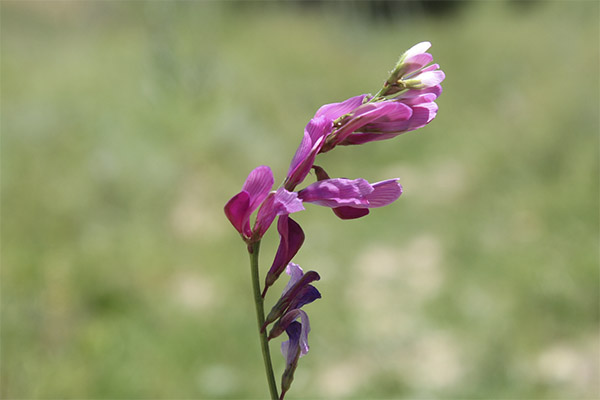
Forms the composition of the herb copeland a set of the following elements necessary for a person:
- Flavonoids are natural antioxidants. They remove toxic products from the body, strengthen the walls of blood vessels, and are also good antispasmodics.
- Estrogens contained in the plant are close in composition to female and male sex hormones. These important substances have a positive effect on the reproductive system and sexuality of both sexes.
- Catechins also belong to the class of flavonoids, but this group of substances has anticarcinogenic activity.
- Saponins are organic compounds that ensure the delivery of proteins to tissue cells. These substances have diuretic and laxative properties and prevent the development of atherosclerosis.
- Coumarins are considered the strongest natural anticoagulants, they relieve spastic pain, prevent tissue degeneration into malignant tumors.
- Xanthones show up as antioxidants to a greater extent, but they work so effectively that they can prevent mutations in the DNA chain.
- Red root tannins normalize gut microflora and help with diarrhea.
- Amino acids take part in the processes of protein synthesis, which are the main building material of human body tissues.
- Alkaloids - these complex compounds are considered poisons, but in reasonable quantities can also benefit people with their ability to quickly and effectively relieve severe pain.
- Vitamin components are represented in Kopecnik ascorbic acid and vitamin A.
- Mineral elements: selenium, nickel, sulfur, aluminum, manganese and a number of other minerals.
Red root also contains ashes, sugars, pectins and other substances that the human body needs.
The rich composition of useful substances of bearberry root turns the wild herb into a valuable plant material. Therefore, today is very in demand in the pharmaceutical industry. It is the basis for the production of medicines and dietary supplements. In folk medicine, red root is used to make tinctures, healing teas, decoctions.
What it looks like and where it grows
Kopetchnik by the nature of the life cycle is a perennial plant. It belongs to the Legumes. In the wild there are shrubby and semi-shrubby species. Bear root or red root has a whole set of distinctive characteristics, by which it is not difficult to identify it in the mass of other representatives of fauna.
Appearance Characteristics
- All kinds of copepod have a very powerful, highly branched root system, which can go up to 5 m deep into the ground. The underground part of the plant has a characteristic red hue, which is reflected in the many names of the culture.
- The stems of the plant are smooth and straight. They have numerous ramifications.
- The leaves of the perennial are rounded, they are distinguished by their large size and are arranged in pairs.
- Small flowers of purplish-purple hue are gathered in a brush-like inflorescence. The flowering period of the buckthorn begins in mid-June and lasts all summer.
- The fruits of the perennial are light green dry beans.
- Under favorable conditions, stone hips may reach a height of up to 1.5 m, but most commonly there are specimens 70-80 cm tall.
Habitat
The most comfortable living conditions for the hickory are meadows, mountain slopes, areas near rivers and other bodies of water. Bear's root is ubiquitous in tundra and coniferous forests. The perennial prefers neutral or weakly acidic soils. Unfortunately, the habitat of this unique plant decreases every year. It takes a lot of effort to find bear root. Wild species of the plant today can be found in Siberia, in the Altai, in the north of Mongolia and in China. Individual species grow in Africa and North America. Siberian herbalists collect pure plant material in the Sayan Mountains.
Today, many enthusiastic gardeners grow copeplants on their garden plots to beautify the local landscape. Cultivated varieties of the plant can be found in park areas.
Useful to know: Hemlock is propagated only by seeds, but the beans retain their germination for 10 years.
Species
It is interesting that all species of red root, and there are about three hundred of them in the world, have medicinal properties. On Russian territory, about 45 different species of kopeck can be found. Among the varieties in demand in official and folk medicine:
- Forgotten Kopeechnik grows in regions of Siberia and Altai. It is widely used by the local population to make medicinal drinks. This subspecies is also called Siberian. This plant material is harvested during the budding and active flowering periods. Leaves and stems are cut.
- The alpine copepod differs from its familymates in its bright appearance and tall stature - 1.5 or more meters. This subspecies has lush tassels of inflorescences, because each includes up to 50 small flowers.
- Tea cinquefoil looks more like a low-growing herb, but its strongly branched root system penetrates deep into the soil and has a strong structure. It is this subspecies that is most valued in medicine, but only the roots are used for medicinal purposes.
- Gmelin's variety is included by botanists into the Red Book, as it is on the verge of complete extinction. Representatives of this subspecies also by all signs belong to herbaceous plants with a well-developed root system. The main habitat area of the Gmelina variety is Asia, Altai, and Mongolia. Occasionally the plant can be found in European countries.
Chalky Kopeechnik has also joined the lists of rare representatives of the fauna of the planet. This low perennial herb likes to settle along riverbanks, on gentle hillsides, and open spaces. The chalky variety reaches a height of no more than 30 cm, the root system is rod-shaped, and the flowers attract bees and people's eyes with a delicate purple-pink hue. This variety is propagated not only by seeds, but also by vegetative method.
Common species can also include Crimean, Arctic, Fergana, and Iberian copepod.
Note: Bear root of the Siberian variety is more in demand in medicine. Plants of this particular species go to the production of medicines and preparation of preparations for folk recipes. Some varieties of Kopeechnik, such as Sakhalin red root, are used in local cuisine as a food additive.
Harvesting and storage
Today, not only hereditary herbalists, but also gardeners and supporters of natural therapies are engaged in harvesting the medicinal varieties of copeland. To properly collect valuable plant material, you need to remember a few important rules:
- The harvesting of plant material of the ground part of the perennial should take place during the period of flower bud formation and the beginning of flowering. This cycle of the plant occurs in June - August.
- The best time to collect the raw material is in the afternoon, when the dew is completely dry.
- The stem is cut at a height of 30 cm from the ground.
- The drying process takes place in the natural environment, in the sun. But you should protect the raw material from moisture.
- The leaves of copeland are often used fresh. They are well preserved, without losing their medicinal properties for a month. Fresh herbs are stored in the refrigerator.
- Rhizomes can begin to be harvested in late summer and fall. But before the ripening of fruits, the underground part of the plant should not be harvested.
- Not the whole root is extracted from the soil, but only 2/3 of it. One part must be left for the plant to develop.
- In the area where the raw material has already been collected, it is not allowed to make a second harvest within 10 years. Such rules are caused by the need to preserve rare species of medicinal plants.
- The selected rhizomes should be immediately cleaned of soil. Large fragments should be cut into small pieces.
- Dry the roots in a room with good ventilation. The optimal place is a window sill.
- The shelf life of well-dried raw material is 3 years.
For long-term storage of dry material should be distributed in canvas bags or paper packaging. Store medicinal raw materials in a dark place where there is no access to moisture.
Medicinal properties of copeland
A rich chemical composition of the medicinal plant can be considered the basis of its therapeutic and beneficial properties. And these characteristics of copeland are many. It is no coincidence that fans of naturalism, which is among the main trends today, add fresh plant parts or dried roots of hickory to their food. Healing drinks using this healing plant are very popular. But with any method of use, red root has an extremely beneficial effect on the work of all organs and systems of the human body. Here are just the main actions of the medicinal herb:
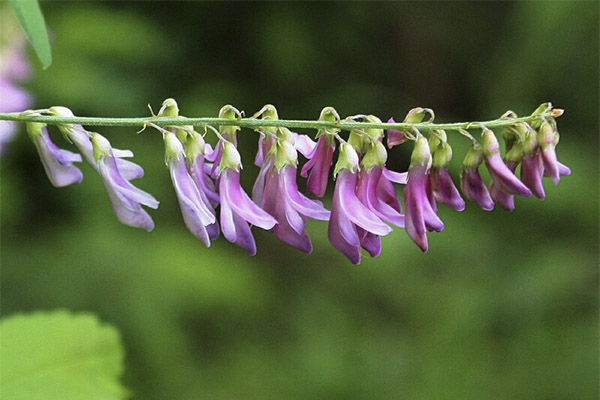
- Stabilizes blood pressure for minor hypertension.
- Stimulates blood circulation.
- Prevents the formation of blood clots.
- Possesses a pronounced expectorant action.
- Cleans the blood from toxic products.
- Lowers body temperature with fevers.
- Relieves the condition during colds.
- Due to antibacterial properties helps to eliminate viruses and other pathogens.
- Regulates the process of hematopoiesis, participating in the formation of red blood cells.
- Provides strength to muscle tissues, including the myocardium.
- Positive effect on the nervous system.
- Increases intestinal peristalsis by strengthening its muscles.
- Improves the protective functions of the immune system.
- Helps in the treatment of a variety of disorders of sexual nature and diseases of the genitourinary system in both sexes.
To this list wants to add a very impressive rejuvenating ability of the herb hyssop, which raises the prospects for its use in home cosmetology.
In what diseases good red root
To start taking preparations with hips, it is not necessary to wait until the body gives a failure in any direction. Healing plant will benefit people who have never complained about health. After all, any living organism needs nutrients, and the underbelly grass contains them in excess.
For therapeutic purposes, medicines with red root as an adjunct will help with the following pathologies:
- diseases of the urogenital system;
- inflammatory processes of the respiratory organs;
- vascular disorders;
- Malignant and benign tumors;
- Bleeding of different origin;
- Depressions and stresses;
- digestive disorders;
- Chlamydia, ureaplasmosis and other sexually transmitted infections;
- sexual disorders;
- circulatory disorders;
- Insomnia and many other pathologies.
Consider in detail what benefits are able to provide burdock representatives of different sexes.
For women
First of all, we want to draw attention to the high content of antioxidants in this plant. This group of substances inhibits the aging process, which slows the appearance of age-related changes on the face. For women, this factor is of great importance. In addition to rejuvenating abilities, taking medicinal formulas with red root will help women in the treatment of such pathologies:
- uterine myoma;
- infertility;
- mastitis;
- heavy periods;
- uterine bleeding;
- erosions;
- Hormonal disorders during menopause;
- painful menstruation.
This wonderful herb will help to improve the sexual side of life, as compositions based on it increase libido.
For men
It is not by chance that copepecum is often called the male root. Even in ancient times, representatives of the strong half of mankind took healing decoctions to enhance strength and increase potency. Thanks to scientific research, today the sphere of application of this medicinal plant has greatly expanded. Means based on the red root are recommended by doctors and folk healers to men suffering from the following pathologies:
- prostatitis;
- sexual weakness;
- diseases of the urinary system;
- male infertility;
- adenoma;
- hormonal disorders.
Kopecks in folk medicine
Although today you can freely buy a variety of dietary supplements, which include the herb kopeck, folk methods of treatment show great effectiveness in the treatment and prevention of various diseases. Therefore, many people are interested in recipes that were used by our ancestors in ancient times.

Here are a few unique recipes that can speed up recovery even with severe forms of disease.
Heart tea
It takes only a few minutes to prepare a healing drink, but a short consumption of such a tea will improve heart function and have a positive effect on general well-being.
How to prepare the composition
Instead of the usual brew, take 1 tsp of crushed roots of copeland (it is better to use the tea variety) and pour a glass of boiling water. The drink should infuse well. This will not require more than 20 minutes. It is recommended to drink hot tea of copeland. Allowed daily dose of the drink - 2 cups.
Cure for sexual weakness and prostatitis
In principle, this recipe can be considered universal, as it helps to cope with almost all male problems. Of course, the therapeutic effect of such a treatment depends on the stage of the disease.
Scheme of preparation: in a thermos, pour 1 tsp of dried roots of copeland, pour the plant material with hot water (not boiling water). Insist the composition for 8 hours. Before use, filter the solution well. Drink 2 tablespoons three times a day. You can for ease of use dilute the medication with water.
remedy for colds
In the old days, this recipe was widely used to treat tuberculosis patients. Therefore, the tincture, prepared according to the proposed scheme, will help to cope with the manifestations of influenza, pneumonia, maxillary sinusitis. It is useful in problems of the reproductive system.
The preparation method: put 50 grams of red root in a container that is not exposed to light, and pour the entire plant mass on top of vodka (0.5 liters). Tincture must be brought to readiness in the dark for 14 days. Take on an empty stomach ½ tsp. up to 3 times. The course lasts for 3-4 weeks.
Expectorant decoction
With a severe dry cough, a remedy prepared according to this recipe will help. In addition to the fact that the medicine with copecinum will accelerate the transition to a productive cough, it will greatly improve the condition of the sick person.
Step-by-step process of preparation:
- In an enamel bowl place 15 g of crushed roots of comfrey.
- Pour the raw material with warm water (300 ml).
- Cover the pan with a lid. Place on a water bath for 30-40 minutes.
- At the end of this time to supplement the volume of liquid to the original amount of water.
- Strain the solution, again bring to a boil.
- Chilled decoction to drink strictly 2 tbsp. before each meal.
- Keep the medication in the refrigerator no more than 3 days.
Strengthening infusion
This remedy is prepared with water. It has general strengthening properties, and will also increase the effectiveness of therapy for respiratory diseases.
How to prepare:
- In a thermos pour 2 tablespoons of crushed roots of the herb kopeck.
- Pour vegetable raw materials with a liter of warm boiled water.
- Insist the drug overnight.
- After straining the infusion to take a glass up to 3 times.
Remedy for herpes
It is known that herpes is very difficult to treat. Sometimes even the most effective ointments can not relieve the unpleasant symptoms of this disease. But a tincture of kopeck on vodka will cope with this difficult task in a few steps.
Preparation:
- 50 g of roots (crushed) first soak for a while in 100 ml of alcohol (you can use vodka), then add another ½ l of fortified liquid.
- In a dark place, place the container with the composition to infuse. Shake the container every day. After 2 weeks, the cure for herpes can be used.
Note: This composition should in no case be taken internally.
Composition for cleansing the blood
This recipe will also help men to restore normal potency. The decoction is prepared as follows:
- In a container, place the root of kopeck in an amount of 10 g, pour a glass of cooled boiled water.
- The solution to determine on a water bath.
- After half an hour remove.
- Insist the medicine for an hour, then strain and bring to a boil.
- Take on an empty stomach 2 tbsp.
Here is only a minimal part of the treasury that has been collected for centuries by folk healers. But any of these recipes, when used correctly, can help eliminate many problems.
Types of healing compositions
Over centuries of practice in the use of healing herbs folk medicine has accumulated many unique recipes. This is why it is not difficult to prepare infusions, teas, tinctures, and tinctures at home in accordance with the recommended dosages. At home, observing the recommended dosages is not difficult to prepare infusions, teas, tinctures with kopeck herb. There are different variants of recipes, but they all differ not by the method of preparation, but by the dosage of ingredients.
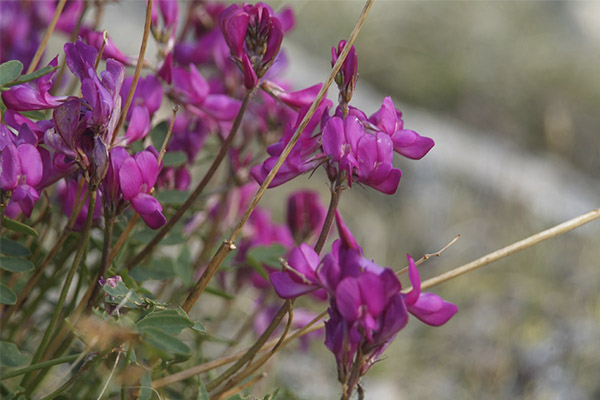
Infusion
To prepare an infusion of the classic recipe, you need to take 25 grams of dried red root and half a liter of boiling water. In a thermos, first pour the herbal raw materials, then pour water. After an hour, the infusion can be taken to accelerate the healing process for respiratory infections, maxillary sinusitis. The norm of the medicine for one reception - one-third of a cup. In the finished drink, you can add a spoonful of honey and a little milk.
To strengthen the immune forces of the body and maintain the overall tone, the infusion is prepared from the ground part of the plant. In this case, 1 tbsp. Dry raw materials should be poured boiling water (0.3 liters). After two hours of infusion, strain the solution. Take the infusion for colds, as well as for the prevention of atherosclerosis.
Tincture .
To prepare this dosage form, it is better to use a container of darkened glass. If there is no such a container, then it is necessary to wrap the container after preparing the tincture with a thick cloth.
Tincture of red root in the classic recipe is prepared as follows:
- Fill the jar on ½ of the entire volume with the herb and on 1/3 of the dry extract.
- Pour the herbal raw material with high-quality vodka.
- Put the container in a dark cool place. Every day the solution should be shaken. After 10 days of infusion, the medicine will be ready.
- Before use, filter the tincture.
- Take a healing drink half an hour before a meal. A single dose for an adult is 1 tsp. This amount of the drug should be diluted in 100 ml of water.
Standard therapeutic course of treatment with tincture of kopeck, prepared according to this recipe, is designed for one month. But if necessary, you can carry out 3-4 courses per year.
Decoction
Decoction of copeland is prepared both from fresh and dried plant raw materials. The leaves and stem of the perennial are suitable for this purpose.
Preparation method:
- For 1/2 liter of liquid base should take 1 tbsp. herb.
- Put the pot on a water bath so that the solution retained the active ingredients.
- At the same time, make a minimum level of fire. In this mode, boil the healing composition for 5-7 minutes.
- After that, leave the solution to infuse for an hour, then carefully filter it.
- Take the decoction up to 4 times a day for 100-150 ml.
Addition: This versatile recipe is suitable for almost any clinical case.
A more concentrated decoction is prepared for enemas, douches and external treatments. It should be kept in a water bath for up to 40 minutes. Then pour the hot solution into a thermos, and insist it for half a day.
Tea
Tea drink with the addition of red root is considered an excellent preventive and restorative tool. It can be drunk in moderation during transitional periods when the number of colds increases. To prepare a healing tea, it is better to use copeland variety Gmelin.
The recipe is very simple: 1 tbsp of dried rhizomes pour a liter of steep boiling water, and then leave it for an hour, so that the drink could better infuse. To improve the taste, you can add a little honey to the tea.
Note: tonic tea with the root of the Siberian herb is best prepared in a thermos.
Contraindications for use
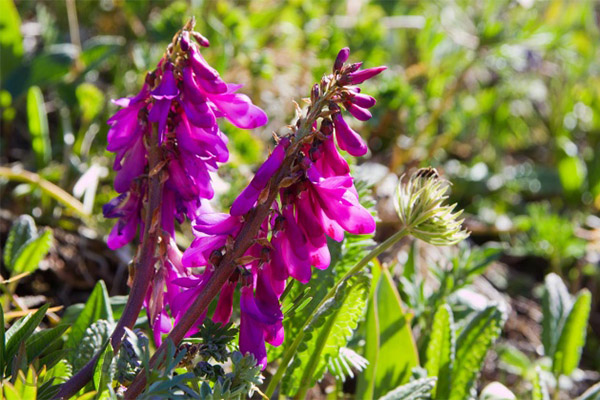
The use of even the most effective herbs does not guarantee complete safety in their use. Red root can also cause damage to health. The list of absolute contraindications for the use of the medicinal plant includes the following conditions and pathologies:
- pregnancy;
- the entire period of breastfeeding;
- individual intolerance;
- previously suffered myocardial infarction;
- craniocerebral injuries;
- any form of heart failure;
- acute cholecystitis;
- thrombophlebitis;
- insufficient renal function;
- severe mental disorders;
- hepatic insufficiency;
- Childhood and adolescence;
- Hypertensive disease of the 2nd degree.
This is a list of standard contraindications that make any kind of use of bear root impossible. But there are still a number of restrictions that must necessarily be taken into account if you want to include the plant in the complex of home treatment.
Special Directions
- Because taking herbal preparations based on copeland increases the effect of some antibiotics and anticoagulants, you should always coordinate with your doctor the use of this plant.
- It is strictly forbidden to take preparations with the herb on an alcohol basis to persons suffering from alcohol dependence.
- It is impossible to treat teenagers with Siberian herb, because the perennial contains components that can adversely affect the puberty of boys and girls in the pubertal period. And the change in hormonal background in the transition period threatens not only physiological disorders, but also mental disorders.
- Overdose of drugs involving copeland can lead to severe headaches, increased nervous excitability, nausea and vomiting. It is not excluded the possibility of developing allergic reactions if the rate of taking medicines from the Siberian herb is exceeded.
- Given the degree of risk, before treating or including in the diet of this certainly useful herb, it is imperative to consult with medical professionals. This is the right decision will minimize the risk of unwanted reactions from the body.
To summarize, we would like to remind you that medicinal plants can really work wonders. But this does not mean that their use should not be controlled by specialists. A reasonable approach to conducting home therapy with the use of kopeck will give the maximum therapeutic effect.
«Important: All information on the site is provided solely for introductory purposes. Before applying any recommendations, consult with a specialized specialist. Neither the editors nor the authors are liable for any possible harm caused by materials."


